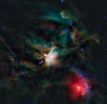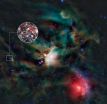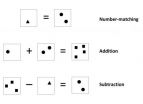(Press-News.org) On the surface, ants and the Internet don't seem to have much in common. But two Stanford researchers have discovered that a species of harvester ants determine how many foragers to send out of the nest in much the same way that Internet protocols discover how much bandwidth is available for the transfer of data. The researchers are calling it the "anternet."
Deborah Gordon, a biology professor at Stanford, has been studying ants for more than 20 years. When she figured out how the harvester ant colonies she had been observing in Arizona decided when to send out more ants to get food, she called across campus to Balaji Prabhakar, a professor of computer science at Stanford and an expert on how files are transferred on a computer network. At first he didn't see any overlap between his and Gordon's work, but inspiration would soon strike.
"The next day it occurred to me, 'Oh wait, this is almost the same as how [Internet] protocols discover how much bandwidth is available for transferring a file!'" Prabhakar said. "The algorithm the ants were using to discover how much food there is available is essentially the same as that used in the Transmission Control Protocol."
Transmission Control Protocol, or TCP, is an algorithm that manages data congestion on the Internet, and as such was integral in allowing the early web to scale up from a few dozen nodes to the billions in use today. Here's how it works: As a source, A, transfers a file to a destination, B, the file is broken into numbered packets. When B receives each packet, it sends an acknowledgment, or an ack, to A, that the packet arrived.
This feedback loop allows TCP to run congestion avoidance: If acks return at a slower rate than the data was sent out, that indicates that there is little bandwidth available, and the source throttles data transmission down accordingly. If acks return quickly, the source boosts its transmission speed. The process determines how much bandwidth is available and throttles data transmission accordingly.
It turns out that harvester ants (Pogonomyrmex barbatus) behave nearly the same way when searching for food. Gordon has found that the rate at which harvester ants – which forage for seeds as individuals – leave the nest to search for food corresponds to food availability.
A forager won't return to the nest until it finds food. If seeds are plentiful, foragers return faster, and more ants leave the nest to forage. If, however, ants begin returning empty handed, the search is slowed, and perhaps called off.
Prabhakar wrote an ant algorithm to predict foraging behavior depending on the amount of food – i.e., bandwidth – available. Gordon's experiments manipulate the rate of forager return. Working with Stanford student Katie Dektar, they found that the TCP-influenced algorithm almost exactly matched the ant behavior found in Gordon's experiments.
"Ants have discovered an algorithm that we know well, and they've been doing it for millions of years," Prabhakar said.
They also found that the ants followed two other phases of TCP. One phase is known as slow start, which describes how a source sends out a large wave of packets at the beginning of a transmission to gauge bandwidth; similarly, when the harvester ants begin foraging, they send out foragers to scope out food availability before scaling up or down the rate of outgoing foragers.
Another protocol, called time-out, occurs when a data transfer link breaks or is disrupted, and the source stops sending packets. Similarly, when foragers are prevented from returning to the nest for more than 20 minutes, no more foragers leave the nest.
Prabhakar said that had this discovery been made in the 1970s, before TCP was written, harvester ants very well could have influenced the design of the Internet.
Gordon thinks that scientists have just scratched the surface for how ant colony behavior could help us in the design of networked systems.
There are 11,000 species of ants, living in every habitat and dealing with every type of ecological problem, Gordon said. "Ants have evolved ways of doing things that we haven't thought up, but could apply in computer systems. Computationally speaking, each ant has limited capabilities, but the collective can perform complex tasks.
"So ant algorithms have to be simple, distributed and scalable – the very qualities that we need in large engineered distributed systems," she said. "I think as we start understanding more about how species of ants regulate their behavior, we'll find many more useful applications for network algorithms."
###
The work is published in the Aug. 23 issue of PLoS Computational Biology.
Stanford researchers discover the 'anternet'
2012-08-29
ELSE PRESS RELEASES FROM THIS DATE:
Kepler discovers planetary system orbiting two suns
2012-08-29
The system, known as Kepler-47, harbours the smallest known transiting circumbinary planets -- planets orbiting a pair of stars -- to date. The planets were discovered using NASA's Kepler space telescope [1] by monitoring thefaint drop in brightness produced when both planets transit (eclipse) their host stars [2].
"In contrast to a single planet orbiting a single star, planets whirling around a binary system transit a moving target," explains Jerome Orosz (San Diego State University, USA), lead author of the study. "The time intervals between the transits and their duration ...
Sweet building blocks of life found around young star
2012-08-29
Life is made up of a series of complex organic molecules, including sugars. A team of astronomers led by researchers from the Niels Bohr Institute, have now observed a simple sugar molecule in the gas surrounding a young star and this discovery proves that the building blocks of life were already present during planet formation. The results have been published in the scientific journal Astrophysical Journal Letters.
The star was observed with the new large international telescope, Atacama Large Millimeter Array (ALMA) in northern Chile. The ALMA telescopes are able to ...
Sweet result from ALMA
2012-08-29
A team of astronomers using the Atacama Large Millimeter/submillimeter Array (ALMA) has spotted sugar molecules in the gas surrounding a young Sun-like star. This is the first time sugar been found in space around such a star, and the discovery shows that the building blocks of life are in the right place, at the right time, to be included in planets forming around the star.
The astronomers found molecules of glycolaldehyde -- a simple form of sugar [1] -- in the gas surrounding a young binary star, with similar mass to the Sun, called IRAS 16293-2422. Glycolaldehyde ...
Adelaide joins with Italy to develop 'super spaghetti'
2012-08-29
University of Adelaide researchers are working with colleagues in Italy to produce better quality pasta that also adds greater value to human health.
Two research projects - being conducted by the ARC Centre of Excellence in Plant Cell Walls at the University's Waite Campus - will start next month in collaboration with researchers from the Italian universities of Bari and Molise.
The aim of the ARC Centre of Excellence is to look at the fundamental role of cell walls (biomass) in plants and discover how they can be better utilized. Both of these new projects will investigate ...
Math ability requires crosstalk in the brain
2012-08-29
A new study by researchers at UT Dallas' Center for Vital Longevity, Duke University, and the University of Michigan has found that the strength of communication between the left and right hemispheres of the brain predicts performance on basic arithmetic problems. The findings shed light on the neural basis of human math abilities and suggest a possible route to aiding those who suffer from dyscalculia-- an inability to understand and manipulate numbers.
It has been known for some time that the parietal cortex, the top/middle region of the brain, plays a central role ...
New 'traffic light' test could save lives with earlier diagnosis of liver disease
2012-08-29
A new 'traffic light' test devised by Dr Nick Sheron and colleagues at University of Southampton and Southampton General Hospital could be used in primary care to diagnose liver fibrosis and cirrhosis in high risk populations more easily than at present.
Liver disease develops silently without symptoms, and many people have no idea they have liver failure until it is too late – one-third of people admitted to hospital with end-stage liver disease die within the first few months. A simple test available in primary care could diagnose disease much earlier, enabling those ...
Internet addiction -- Causes at the molecular level
2012-08-29
"It was shown that Internet addiction is not a figment of our imagination," says the lead author, Privatdozent Dr. Christian Montag from the Department for Differential and Biological Psychology at the University of Bonn. "Researchers and therapists are increasingly closing in on it." Over the past years, the Bonn researchers have interviewed a total of 843 people about their Internet habits. An analysis of the questionnaires shows that 132 men and women in this group exhibit problematic behavior in how they handle the online medium; all their thoughts revolve around the ...
Twitter data crunching: The new crystal ball
2012-08-29
Fabio Ciulla from Northeastern University, Boston, USA, and his colleagues demonstrated that the elimination of contestants in TV talent shows based on public voting, such as American Idol, can be anticipated. They unveiled the predictive power of microblogging Twitter signals--used as a proxy for the general preference of an audience--in a study recently published in EPJ Data Science¹.
The authors considered the voting system of these shows as a basic test to assess the predictive power of Twitter signals. They relied on the overlap between Twitter users and show audience ...
Earphones 'potentially as dangerous as noise from jet engines,' according to new study
2012-08-29
Turning the volume up too high on your headphones can damage the coating of nerve cells, leading to temporary deafness; scientists from the University of Leicester have shown for the first time.
Earphones or headphones on personal music players can reach noise levels similar to those of jet engines, the researchers said.
Noises louder than 110 decibels are known to cause hearing problems such as temporary deafness and tinnitus (ringing in the ears), but the University of Leicester study is the first time the underlying cell damage has been observed.
The study has ...
New research eclipses existing theories on moon formation
2012-08-29
Oxford, August 29, 2012 - The Moon is believed to have formed from a collision, 4.5 billion years ago, between Earth and an impactor the size of Mars, known as "Theia." Over the past decades scientists have simulated this process and reproduced many of the properties of the Earth-Moon system; however, these simulations have also given rise to a problem known as the Lunar Paradox: the Moon appears to be made up of material that would not be expected if the current collision theory is correct. A recent study published in Icarus proposes a new perspective on the theory in ...




